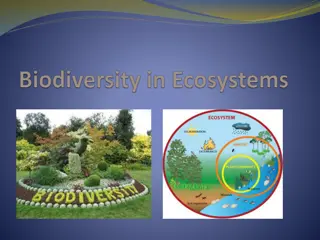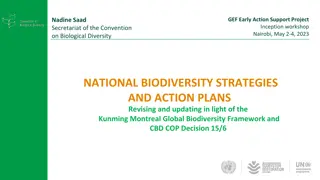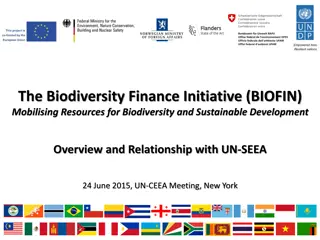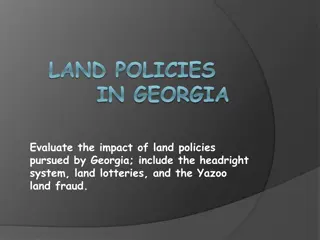Understanding Biodiversity Net Gain (BNG) in Development and Land Management
Biodiversity Net Gain (BNG) is an approach in development and land management to enhance the natural environment by creating or improving habitats. It aims to leave the environment in a better state than before, providing measurable benefits for biodiversity. Existing duties and upcoming mandatory requirements in England will shape how BNG is integrated into planning decisions.
Download Presentation

Please find below an Image/Link to download the presentation.
The content on the website is provided AS IS for your information and personal use only. It may not be sold, licensed, or shared on other websites without obtaining consent from the author. Download presentation by click this link. If you encounter any issues during the download, it is possible that the publisher has removed the file from their server.
E N D
Presentation Transcript
Biodiversity Net Gain (BNG) An Introduction William Dommett MSc MCIEEM District Ecologist
Introduction What is Biodiversity Net Gain (BNG) Biodiversity net gain (BNG) is an approach to development, and/or land management, that aims to leave the natural environment in a measurably better state than it was beforehand BNG delivers measurable improvements for biodiversity by creating or enhancing habitats in association with development BNG can be achieved on-site, off-site or through a combination of on-site and off-site measures
BNG Existing duties to enhance BNG is not a new concept. National Planning Policy Framework (NPPF) para 174(d): 174. Planning policies and decisions should contribute to and enhance the natural and local environment by: (d) minimising impacts on and providing net gains for biodiversity, including by establishing coherent ecological networks that are more resilient to current and future pressures;
BNG Existing duties to enhance Natural Environment and Rural Communities (NERC) Act 2006: 40. Duty to conserve and enhance biodiversity (3)The action which may be taken by the authority to further the general biodiversity objective includes, in particular, action taken for the purpose of (a)conserving, restoring or otherwise enhancing a population of a particular species, and (b)conserving, restoring or otherwise enhancing a particular type of habitat.
What is Mandatory Biodiversity Net Gain? From November 2023 (date TBC) under the Environment Act 2021, all major planning permissions (10 or more dwellings) granted in England (with a few exemptions) will have to deliver at least 10% biodiversity net gain The requirement is mandatory (not policy) and once enacted will modify the Town and County Planning Act (T&CPA)1990 with a new s90a and schedule 7A The requirements for Small Sites (<10 dwellings) will come into force from April 2024 (date TBC) There is still secondary legislation and guidance to be released by the government so some details are not fully confirmed
BNG what it applies to Applies to all land development to low water mark, except permitted development. Does include: Brownfield development Change of use applications Temporary permissions Small sites Residential: <10 dwellings on <1ha site OR unknown number on <0.5ha site; Non-residential: floorspace <1000 m2 OR < 1ha site
BNG does not include Does not include Permitted development Marine development Where a site s baseline biodiversity score is zero (e.g., hardstanding, sealed surfaces) Where temporary impacts will be restored within two years (under the NE metric v4.0)
BNG does not include Secondary legislation (not yet published) to specify further exemptions: De minimis habitat area threshold of 25 m2 / 5 m (linear habitat) Householder applications Biodiversity gain sites, e.g., to create biodiverse habitats such as ponds, woodland etc. Small scale self-build and custom housebuilding (TBC) Irreplaceable habitats These could still be subject to local plan BNG policy
New general planning condition New statutory general planning condition inserted into the T&CPA 1990 Summary: No commencement of development until a Biodiversity Gain Plan (BGP) has been submitted to and approved by the Local Planning Authority (LPA) Applies to every planning permission granted Condition cannot be removed, modified or disapplied
Biodiversity Gain Plan Developer must deliver a Biodiversity Gain Plan The plan must show biodiversity gain of at least 10% between: 1. pre-development biodiversity value of onsite habitats ; and 2. biodiversity value attributable to the development The plan must include a completed statutory approved metric demonstrating the calculations and minimum 10% gain Development cannot commence until LPA has approved the Biodiversity Gain Plan
Biodiversity Gain Plan The Biodiversity Metric 4.0 (current version) is an Excel based tool that use the type, condition, and area of habitats as a proxy for change in biodiversity from before to after a development, in terms of Biodiversity Units (BUs). The difficulty of enhancing an existing habitat or creating a new habitat, as well as the time taken to do so, are factored into the metric calculation. In England, a development will need to show a minimum 10% increase in BUs, compared to the baseline, to demonstrate that BNG can be delivered.
Biodiversity Gain Plan It is important to remember that BUs derived using the metric are only a proxy for biodiversity and additional ecological data must be used to design BNG based on sound ecological practices The metric uses habitats as a proxy i.e. does not address: Species Protected sites Irreplaceable habitats Indirect impacts Cumulative / in combination impacts
Baseline habitat value Developer measures pre-development biodiversity value of onsite habitats, i.e., within the redline planning boundary To be measured within 12 months of an application (or otherwise specified) Need to be undertaken by a competent ecologist using the UK Habitats Classification and NE habitat condition assessment There are measures to prevent deliberate downgrading of habitat values prior to submitting planning applications Anti-trashing measures
Mitigation hierarchy Biodiversity net gain in England is underpinned by the mitigation hierarchy, which is set out in the National Planning Policy Framework Information outlining how the mitigation hierarchy has been adhered to, including evidence of the steps taken to avoid and/or minimise adverse biodiversity impacts, must be included within the biodiversity gain plan Financial cost is not adequate reasoning for failing to avoid or minimise negative effects
Mitigation hierarchy avoidance To evade or reduce biodiversity impacts through site selection and layout Project proposals must give the highest priority to avoidance strategies as the primary approach in order to adhere to the mitigation hierarchy Examples: Site selection Retention of valuable habitat features, e.g., woodland. Early engagement with the process is recommended, i.e., prior to site design
Mitigation hierarchy minimise To take measures to reduce the duration, intensity and/or extent of impacts to biodiversity Where avoidance is not feasible, it is essential to minimize any potential negative impacts by modifying the project design and strategy to the fullest extent Examples: Indicate retained vegetation e.g. hedgerows and existing trees; Limiting the size of the site / protecting key areas; Sensitive landscape design in line with industry best practice e.g. CIEEM BNG
Mitigation hierarchy mitigate The condition of on-site habitat or an affected area is improved and/or protected. Including enhance, restore, or regenerate biodiversity on-site All non-avoidable ecological damage must be adequately replaced/ mitigated for with the guidance and expertise of a trained ecologist Examples: Replanting, timing works Redesigning aspects of the site to reduce the impacts (such as lighting).
Mitigation hierarchy compensate or offset Compensating for any residual, adverse, unavoidable impacts after full implementation: onsite or offsite The final resort after all other options have been exhausted as the most expensive, complex, and high-risk approach Examples: Using the biodiversity net gain offsetting mechanisms, including through the creation or enhancement of off-site habitats, either on owned land, by purchasing biodiversity units on the market, or statutory credits.
Anti trashing The LPA will check if correct pre-development onsite value is being declared in the Biodiversity Gain Plan Any activities on / after 30 January 2020 that have contributed to the downgrading of a sites biodiversity value, e.g., vegetation clearance, will not be accepted as the baseline value for the site This includes if a site is trashed and then sold on The pre-development onsite value is the value immediately before site clearance will be used The pre-trashing value will assume any habitats were in good condition
Biodiversity Metric 4.0 The Rules! Natural England (2023). The Biodiversity Metric 4.0 User Guide.
Baseline Area habitats Measured in hectares (Ha)
Baseline Hedges and ditches Measured in kilometres (Km)
On-site Provision of new biodiverse green space Enhancement of existing features Tree planting New hedgerow planting Retention of important habitats
Off-site Any site delivering off-site biodiversity units must be registered on the Natural England biodiversity gain site register Each site will have a unique reference number that is tied to planning reference There biodiversity metric has built in measures to disincentive provision of off-site units outside of LPA boundaries Registration requires legal commitments to create habitat enhancements and maintain them for at least 30 years after completion of the enhancements S106 or Conservation Covenant (TBC)
Small Sites Metric (SSM) The Small Sites Metric (SSM) is a simplified version of the Biodiversity Metric 4.0. It has been specifically been designed for use on small development sites where the project chooses to do so. Such sites are defined (for the purposes of this Small Sites Metric) as small sites where the following criteria are met: For residential development: - there are fewer than 10 residential units on a site area (no more than 9 units) less than 1 hectare; or - if number of residential units is not known, the site area is less than 0.5 hectares For non-residential development: where the floor space to be created is less than 1,000 square; or where the site area is less than 1 hectare
Small Sites Metric (SSM) Biodiversity units are calculated using the size of a parcel of habitat and its quality The SSM uses area (measured in m2) and length (measured in m) The SSM cannot be used on such sites where: Habitats not available in the SSM are present Priority habitats are within the development site (excluding some hedgerows and arable field margins) European protected species are present on the development site, e.g., bats, dormice, otter, great crested newts Any offsite interventions are required
Small Sites Metric (SSM) A competent person must carry out the habitat survey and complete the SSM calculation. Users of the SSM should be competent in identifying: Habitats present on site (pre-development) Management requirements for habitats to be created or enhanced within the landscape design (post-development) Competency is aligned with the British Standard Process for designing and implementing biodiversity net gain: BS 8683:2021 Does not have to be an ecologist but details must be provided as to the metric users competency
Statutory credits Last resort sold by the government on an online platform (TBC) Deliberate high price as a disincentive Money used by government for enhancement works or to buy land Proof of purchase required within the Biodiversity Gain Plan Likely to be phased out once the off-site market is functioning
Reference material Biodiversity Net Gain 2022 consultation events | Local Government Association UK Green Building Council ukgbc.org Baker et al. (2019). Biodiversity net gain. Good practice principles for development. CIEEM (2019). InPractice. Issue 104. Biodiversity Net Gain. Natural England (2023). The Biodiversity Metric 4.0 User Guide.























